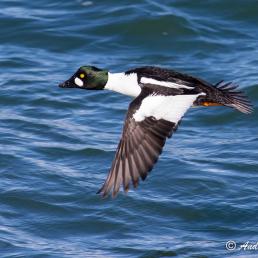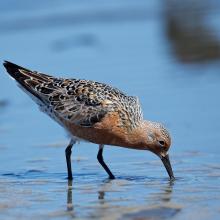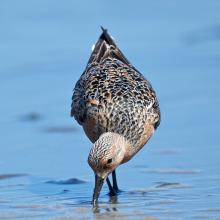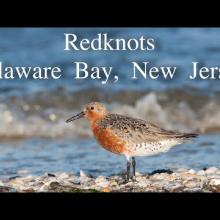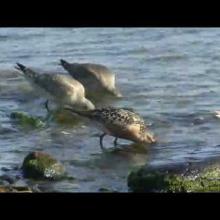

Join BirdNote tomorrow, November 30th!
Illustrator David Sibley and actor H. Jon Benjamin will face off in the bird illustration battle of the century during BirdNote's Year-end Celebration and Auction!
Scott Weidensaul, author of Living on the Wind, says “. . . the longest, most amazing, most awe-inspiring migrations are the ones that are most delicately balanced. And if you perturb any of the supports on which it depends, the whole thing collapses like a house of cards.” Fortunately, the U.S. National Wildlife Refuge System protects habitat for migratory birds like these Red Knots, which travel an astonishing 9,300 miles between its Arctic breeding grounds and its wintering habitat in southern South America!
BirdNote®
Is Long-distance Migration Becoming a House of Cards?
With Scott Weidensaul
By Todd and Chris Peterson
This is BirdNote.
[Andante from Mysterious Mountain by Hovhaness]
During migration, birds make journeys requiring skill and stamina completely unachievable by humans. Here’s Scott Weidensaul, author of Living on the Wind, with an example: [Sound of strong wind]
“You think of a tiny little warbler that weighs less than half an ounce…making 80 or 90 hour non-stop flights that are the equivalent of humans running four-minute miles for days with no food or water or rest.”
Yet the cycle of bird migration is in many ways fragile.
“They’re already fighting wind and rain and storms and exhaustion and predators, but we keep making it an increasingly difficult world for them. Because we alter the landscape…the stopover locations where they can rest and regain their weight are becoming harder and harder for them to find.”
[“Migration, especially long-distance migration…balances on the physiological abilities of the bird, on climate and weather, on the availability of food…if you diminish the ability of the land to support them, if you change the climate which changes weather which changes wind patterns which changes when the food is available…”]
[Calls from flock of Red Knots]
“The thing that worries me the most is that the most remarkable migrations, the longest, most amazing, most awe-inspiring migrations are the ones that are most delicately balanced. And if you perturb any of the supports on which it depends, the whole thing collapses like a house of cards.”
But let’s not leave it there. “Our National Wildlife Refuge System as a whole has probably protected more migratory bird habitat than any other initiative.”(1) Examples include Bombay Hook in Delaware, Bosque [boss-kay] del Apache in New Mexico, and Bear River in Utah. Such places aid remarkable creatures on their way. Find more at birdnote.org.
###
Musical selection, Andante, from Mysterious Mountain, Alan Hovhaness, played by the Chicago Symphony Orchestra, Fritz Reiner conductor, Red Seal records.
Wind Nature Essentials #02 recorded by Gordon Hempton of QuietPlanet.com.
Bird sounds provided by The Macaulay Library of Natural Sounds at the Cornell Lab of Ornithology, Ithaca, New York. Flock calls of Red Knot [10001] recorded by Martyn Stewart; calls of individual Red Knot [137542] recorded by Gerrit Vyn.
BirdNote’s theme music was composed and played by Nancy Rumbel and John Kessler.
Producer: John Kessler
Executive Producer: Chris Peterson
© 2014 Tune In to Nature.org January 2014 Narrator: Michael Stein
ID# migration-19-2014-01-09migration-19Zoom Disk 1 Track 14 between 8 – 10 mins.
(1)Scott Weidensaul, email correspondence 10/28/13.
Weidensaul, Scott, Living on the Wind, Across the Hemisphere with Migratory Birds. North Point Press, New York. 1999.
